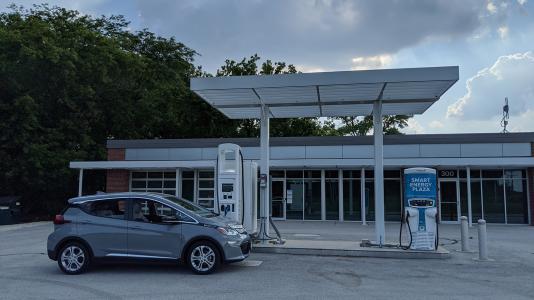
Direct-current fast charging (DCFC) — the latest widely deployed electric vehicle (EV) charging technology — is able to add several hundred miles of electric driving range in less than an hour, versus the typical 8–12 hours for regular AC charging. As a standard feature on many new EVs, DCFC is expected to greatly expand consumer acceptance of electric vehicles. Preliminary data from a study by the U.S. Department of Energy’s Argonne National Laboratory indicates that differences among DCFC implementations used in modern EVs greatly impact the amount of power the electric grid must be able to deliver.
“With DCFC, charging components for conversion of alternating current (AC) as provided from the grid to direct current (DC) for vehicle battery charging are relocated from the vehicle to the charging station,” said Kevin Stutenberg, a principal research engineer in Argonne’s Energy Systems division. “Larger, more powerful charging equipment can be used, greatly increasing the available power and reducing the charging time required.”
“We plan on collecting a total of more than 120 DC Fast Charge events to provide data for analysis of the impacts of the different conditions on each vehicle,” Stutenberg said. “Each vehicle controls charging differently and responds differently to varying ambient conditions.”
Stutenberg and colleagues have undertaken an effort to characterize DCFC, investigating the characteristics of four modern production EVs — a 2020 Tesla Model 3, a 2020 Nissan Leaf E-plus, and 2017 and 2020 Chevrolet Bolt models. The vehicles were selected based on their status as bestsellers in the U.S. market; each vehicle also uses a different type of EV charging connection, either the CHAdeMo, SAE Combo Charging Standard (CCS), or Tesla Supercharger.
“The testing is being performed both onsite at Argonne, and offsite at public DCFC stations throughout the Chicagoland,” said Dan Dobrzynski, an electrical engineer at Argonne’s EV Smart Grid Interoperability Center. Onsite testing leverages the hardware at Argonne’s Smart Energy Plaza, offering both CCS and CHAdeMO DCFC capability at power levels up to 200kW (and soon 350kW). Offsite testing provides access to the Tesla Supercharger network and allows for a greater variety of vehicle to DCFC station combinations, providing a broader picture of the impacts of the different charging protocols and specific charge station limitations.
“Each vehicle controls charging differently and responds differently to varying ambient conditions,” Stutenberg said. “We plan on collecting a total of more than 120 DC Fast Charge events to provide data for analysis of the impacts of the different conditions on each vehicle.”
Each of the four vehicles is instrumented to provide data on vehicle operation during charging, capturing key insight into battery temperature, battery voltage, current and power limits. The Midwest climate also provides large temperature variations throughout the year — a critical element as ambient temperature directly affects the battery temperature, which in turn impacts charging characteristics.
“This effort is designed to capture data on the variety of DCFC stations that are out there, and the impacts that both the station and other factors such as vehicle level of charge and outside temperature have on the charge profile,” Stutenberg said. “The outdoor air temperature impacts the battery temperature and the rate at which the battery can charge is heavily dependent on its temperature. If the temperature is too cold or too hot, damage to the battery can occur, so manufacturers deploy sophisticated thermal control systems in order to keep the batteries within a desired temperature range.”
The early data indicate varying implications for the grid, Stutenberg said.
“If several electric vehicles were charging at the same time at nominal peak power levels of 250kW, a single hub of DCFC stations would consume several Megawatts of power,” he said. “Data collected so far have confirmed that, independent of manufacturer, the advertised maximum charge power (higher charge power indicative of a shorter charge time) is seen only briefly.”
The point of this effort is to capture and quantify current generation electric vehicles’ fast charge profiles as comprehensive datasets do not currently exist,” Stutenberg continued. “This data will be used in many ways, including uncovering where common vehicle level constraints may exist, and validating and improving models of EV charging impacts on the electric grid.”
The DOE’s Office of Energy Efficiency and Renewable Energy funds the project.